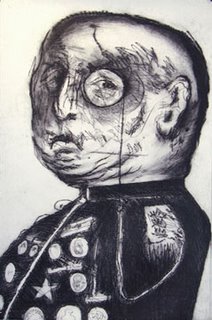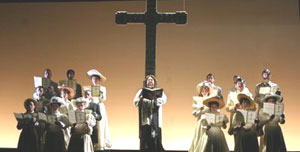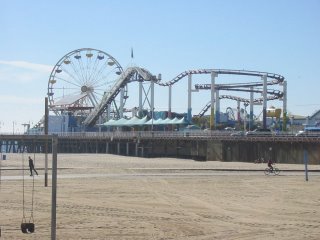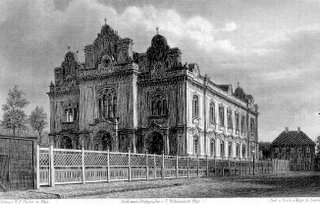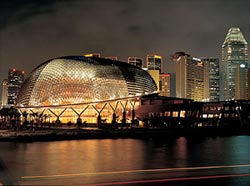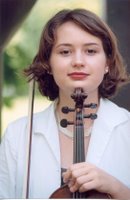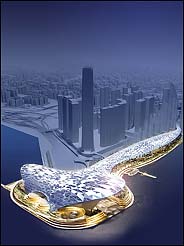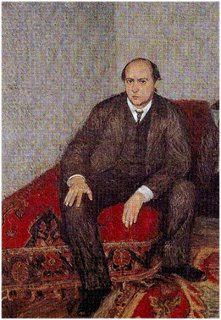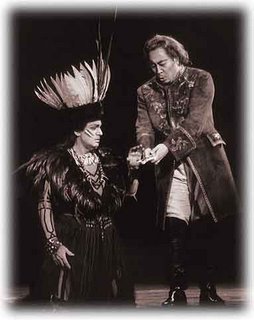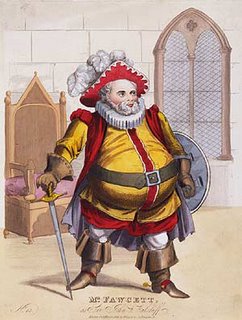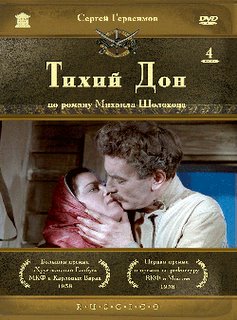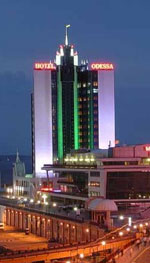Over the next four Saturdays, the Metropolitan Opera, in New York City, will be broadcasting live over radio its Saturday matinee performances, as it has for 75 years.
The next four Saturday matinee radio broadcast performances are Verdi's Aida, Saint-Saëns's Samson and Dalila, Gounod's Romeo and Juliette, and Verdi's La Forza del Destino (The Force of Destiny). [These operas will be sung in Italian or French, the original languages for these operas]. The music to all of these operas is generally well known to many classical music lovers, as are the stories to all, except for perhaps the second Verdi opera, which features beautiful music but a rather complex story-line.
However, next month, March 2006, something new will be taking place at the Metropolitan Opera, in New York City, and on the Metropolitan Opera radio broadcasts around the world. The New Metropolitan Opera will be staging for the very first time, ever, Tchaikovsky's great Russian language opera, Mazeppa. [The Russian National Opera of Petersburg has mounted this opera, as a guest company at the Metropolitan Opera House, in New York City, and the John F. Kennedy Center for the Performing Arts, in Washington, D.C., and I believe that the San Francisco Opera has staged it, too.]
Monday, March 6, will be the Metropolitan Opera first showing of this masterpiece, which Tchaikovsky based on a non-fiction story (based on actual history) by Russia's greatest and most beloved poet, Aleksander Pushkin (who, interestingly, was of mixed European and African ancestry, and who died at the age of 38 in a duel while defending his wife's honor).
A New Metropolitan Opera global radio broadcast, for the first time, of Tchaikovsky's Mazeppa will be on Saturday, March 18, at 1:30 PM (North American East Coast Time).
*
Now, let's take a closer look at what the new humanists at the New Metropolitan Opera have prepared for anyone at all in the world with access to a computer (this includes regular MET Opera patrons living in Greenwich, Connecticut or Pacific Heights, San Francisco; or poor students, workers, or retirees living in the poorer parts of the Americas, the poorer parts of Europe, the poorer parts of Asia, or the poorer parts of the Former Soviet Union).
Perhaps you want to know who the characters are in this opera and who is singing them. You go to (and hope that the new humanists at the New Met will have included a language that you can read):
http://www.operainfo.org/broadcast/operaMain.cgi?id=116&language=1
Perhaps you want to know the story. You go to:
http://www.operainfo.org/broadcast/operaStory.cgi?id=116&language=1
Perhaps you are a teacher, or a parent, and you want teaching ideas. You go to:
http://www.operainfo.org/broadcast/operaTeacher.cgi?id=116&language=1
Perhaps you want to learn more about the opera's background. You go to:
http://www.operainfo.org/broadcast/operaBackground.cgi?id=116&language=1
Here is a sample of what you'll find:
Mazeppa BackgroundUkraine
Settling the Ukraine
Ivan Stephanovich Mazepa (c1640-1709)
Tchaikovsky's Mazeppa
UkraineSurrounded by Russia, Moldova, Hungary, Poland, and Romania, the rich, fertile land along the Dnieper River (today’s Ukraine) has tempted its neighbors for centuries. The area’s complex history is full of war and political intrigue—a tale of near-constant struggle between local rulers and the great powers surrounding their land. Tchaikovsky’s Mazeppa is set against this turbulent backdrop. It tells the story of Cossack Hetman (ruler) Mazeppa, a vassal of the Tsar, who attempted to carve out an independent state by siding with Russia’s enemies—and lost everything in the gamble.
Settling the UkraineFor a long time, the inhabitants of the Dnieper’s left (east) bank were ruled by the Polish-Lithuanian Kingdom. They were serfs, peasants tied to their land and owned by their Polish overlords. They also faced religious persecution—the staunch Roman Catholic Poles wouldn't stand for their serfs' Orthodox practices. Many peasants fled these conditions, abandoning their homes and escaping to an area below the Dnieper River. They realized that in order to stand a chance against the surrounding powers, they would need to organize and unify. They established an elite military order called the Zaporozhian Sich (meaning "clearing beyond the rapids"), and eventually earned fame for their skill as horsemen and warriors. Over time, they became known to the world as Cossacks, from the Turkic word for outlaw.
The Cossack Host (state) was semi-militarized, fully equipped with cannons, falconets, and firelocks. They were strong for their size—but not strong enough to defeat the Poles, Russians, and Turks, who dominated them militarily during the seventeenth and eighteenth centuries. The Cossacks constantly sought ways to secure their independence. In 1654, the Council of Pereslavl, which brought together all of the Cossack Hosts and their Hetman Bohdan Khmelnytsky, decided to unite the lands on the left bank of the Dnieper River with Tsarist Russia. This freed left bank Cossacks from Polish serfdom, but left them vulnerable to Russian domination. Russia attempted to alienate the Ukrainian Cossacks from their ethnic roots, banning the Ukrainian language and suppressing the Ukrainian (Uniate) Church. Russians would eventually label the land below the Dnieper River "Little Russia."
Struggling to regain some independence from Russia, the left bank Cossacks signed the Treaty of Haydach with the kingdom of Poland-Lithuania in 1658. This treaty gave left bank inhabitants more independence under the crown of Poland-Lithuania. For the first time in its struggle, Ukraine was gaining power. But the determined Cossacks just couldn't get a break – the agreement was thrown out just a few years later, when long-warring Tsar Alexis and King John II of Poland-Lithuania made peace. Poland-Lithuania and Russia carved up the Ukraine between themselves. Russia gained control of left-bank Ukraine, including Kiev, and recognized Poland's control over the river’s right bank.
The Hetman Mazepa sought to free the Cossacks from Russian domination by joining Sweden in the Great Northern War against Russia (1700-1721). But the Swedes were decisively defeated by Tsar Peter the Great at the Battle of Poltava in June 1709, crushing all Cossack hopes of independence and severely limiting the autonomy of the "Little Russians."
Ivan Stephanovich Mazepa (c1640-1709)Born into a noble family in the city of Bila Tserkva in the Dnieper Upland, Mazepa jumped from one position of power to the next. From his early days as page to the Royal Polish Court of Jan II Casimir Vasa, he rose to become General Osaul (head officer) of the Cossack army. He finally took his place as the Cossack Hetman of left bank Ukraine in 1687.
Mazepa felt the Russian Tsar was cheating the left bank Cossacks out of the power they were promised at the Council of Pereslavl. He dreamt of breaking away from Great Russia and forming his own, independent realm, where he alone was master. So Mazepa decided to betray Peter the Great and secretly plotted to join Polish King Stanislaus Leszczynski, and later Charles XII of Sweden, in the Great Northern War.
Because Mazepa and the Russian Tsar Peter the Great had been on good terms for a long time, the Tsar initially refused to believe reports that Mazepa was planning to betray him. The Tsar was shocked when, in 1708, Mazepa publicly joined Charles XII of Sweden in the fight against Russia.
Unfortunately for Mazepa, his bold move didn't make as much of a splash as he had hoped. Much to his surprise, not many of his people supported him; in fact only half of one battalion followed him into battle. Most Cossacks remained loyal to the Tsar. Peter the Great instigated a long and arduous string of battles; his forces stormed Mazepa's capital of Baturin and killed its six thousand inhabitants. Peter the Great finally defeated Charles XII and Mazepa in June 1709 at the Battle of Poltava. The victorious Russians hunted down and murdered all of Mazepa's supporters, redistributing their lands to Cossacks loyal to the Tsar. Charles, Mazepa, and three thousand followers fled to the Turkish-owned city of Bendery, where Mazepa died later that year. He was buried at Saint George's Monastery in Galati, a city in Southern Romania.
The majority of Western historians contend that Mazepa's actions were selfish; they argue that he was a greedy leader whose chief concern was extending his own wealth and influence. By swearing allegiance to the Swedes, Mazepa thought he could hold onto the reigns of power when the Russians were defeated. But siding with the Swedes didn't do much for Mazepa's reputation. When people realized that an alliance with Sweden would not bring Cossacks independence, only a Swedish monarch, Mazepa's once suspect reputation was permanently damaged. Today, however, some look to Mazepa as a proto- nationalist champion of Ukrainian independence.
Tchaikovsky's MazeppaComposer Piotr Ilyich Tchaikovsky was an ardent Russian nationalist. He portrayed the character of Mazeppa as a ruthless, power-hungry tyrant who cared about no one but himself.
Mazeppa's libretto was based on Poltava, an epic poem by Alexander Pushkin, Russia’s greatest poet. Pushkin based his story on historical events at Poltava, the battle where Tsar Peter the Great defeated Swedish King Charles XII. Pushkin took some creative license, jettisoning historical accuracy in order to create powerful characters and grand passions. For example, Kochubei (the wealthy Cossack whose daughter elopes with Mazeppa) may not have denounced Mazepa in order to punish him for stealing his daughter; Kochubei actually turned Mazepa in to the Tsar four years after Maria ran away with the Hetman.
Tchaikovsky first told his publisher about the idea of an opera based on Poltava in the summer of 1881, only four months after The Maid of Orleans was produced. Tchaikovsky soon became obsessed with Poltava's story of tragic love and political betrayal. He quickly produced four numbers, and sketched a duet based on material from his symphonic poem Romeo and Juliet (this music later became Mazeppa and Maria's great Act II duet). Librettist Burenin followed Pushkin's poem, incorporating large excerpts from Poltava into his libretto. But Tchaikovsky wasn't overly pleased with Burenin's work – he felt "no special enthusiasm for the characters," and went on to make some critical changes of his own. The libretto was revised over and over again, even after the opera's double premiere in Moscow and St. Petersburg in 1884.
Tchaikovsky wanted to create a juicy tale that combined political betrayal with desperate love. Choosing to focus primarily on the love story at the heart of the opera, he added the character Andrei: a lovesick boy whose unrequited love for the beautiful Maria gives her tragic fate a special poignancy. Mazeppa shares many characteristics with Tchaikovsky's Eugene Onegin. Not only were both operas based on works by Pushkin, they both center on a young woman whose powerful love draws her into a catastrophic downward spiral.
Tchaikovsky's Mazeppa filled opera houses when it opened in Moscow in 1884. This overlooked masterpiece will make its debut at The Metropolitan Opera this spring.
© Copyright 2006 The Metropolitan Opera Guild
*
I hope that my readers, if any, will try either to attend this great opera that the New Metropolitan Opera is staging next month [despite the not yet lowered ticket prices]; or that they will try to listen to the Saturday radio broadcast (afternoon on the East Coast of North America, but morning on the West Coast of North America).
The artists, administrators, humanists, and funders at the New Metropolitan Opera are doing all this because a Great Nation deserves Great Art.

George Tsypin's Set design to the Metropolitan Opera's premiere production of Tchaikovsky's Mazeppa.
Photo credit: The Metropolitan Opera Guild.

